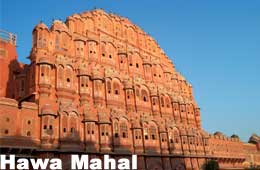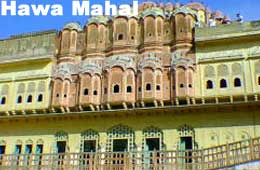| India Profile » Monuments and Temples in India » Hawa Mahal, Jaipur | |
Hawa Mahal, Jaipur | |
 | |
|
The Hawa Mahal provides a striking view of the city of Jaipur. The building was certainly was not meant for residential purposes. It lacks in ornamentation on the inner side of the building. The chambers are plain and more mass of pillars and passages leading to the top story. It does not seem to be part of the same building. It was probably conceived with the aim of enabling ladies of the royal household to watch the everyday life and royal processions in the city without being seen by others. It was built at a time when royal ladies observed very strict purdah system. The palace, with its screened balconies, provided the ladies of the zenana (royal household) an opportunity to watch processions and other activities on the streets below without being observed themselves. The openings here are almost like peepholes, partially block by fine latticework in lime plaster, and some with plain wooden windows. The royal ladies not only enjoyed the view but also did so in great comfort and style
The facade of the Hawa Mahal looks more like a delicate screen than a palace from the roadside. It is a five-storeyed, pyramid-shaped structure. It is made up of tiers one over another with 953 small casements. Each casement had a tiny lattice worked (Jali) pink windows, small balconies and curved roofs with hanging cornices. They were delicately sculptured and carved. The entrance to Hawa Mahal is from the City Palace. An imposing door opens into a spacious courtyard, which has a double storeyed building on three sides. The eastern wing has three more storeys above, which has thickness of just a single room. The building stands over a high podium. There is a lack of regular stairs to reach the upper floors, but have only ramps in order to facilitate the servants to carry the palanquins. The Hawa Mahal stands true to its name. As one climbs up to the balconies, he is almost swept away by the cool breeze. There is a small archeological museum here to provide a glimpse of art and craft of Rajasthan. Hawa Mahal, which is currently under the supervision of the State Archeological Department, provides the visitor with excellent views of the city. The best time to view Hawa Mahal is sunrise when sunlight through the latticed windows gives it a wonderful glow. |
|
 |
 The Hawa Mahal or the Palace of the Wind is one landmark of Jaipur and a monument famous all over the world. It was built by Maharaja Sawai Pratap Singh in 1799 AD. It is an inherent part of the City Palace and was a later addition. The Hawa Mahal was an extension of the ladies chamber, zenana standing away from the main complex. It was the last part of entire complex made for royal harem and guarded by battalion of sentries. The building was designed by Lal Chand Usta and dedicated it to Lord Krishna and his beloved Radha. It is made of red and pink sandstone and the outlines of white border and motif's are painted of quick lime. It is one of the finest examples of Rajput architecture and artistry.
The Hawa Mahal or the Palace of the Wind is one landmark of Jaipur and a monument famous all over the world. It was built by Maharaja Sawai Pratap Singh in 1799 AD. It is an inherent part of the City Palace and was a later addition. The Hawa Mahal was an extension of the ladies chamber, zenana standing away from the main complex. It was the last part of entire complex made for royal harem and guarded by battalion of sentries. The building was designed by Lal Chand Usta and dedicated it to Lord Krishna and his beloved Radha. It is made of red and pink sandstone and the outlines of white border and motif's are painted of quick lime. It is one of the finest examples of Rajput architecture and artistry.  These small windows circulate cool air even during hot months. The pyramidal outline is even throughout by cramming and multiplying casements and the use of repetition of motifs is done to enhance its beauty. The building is 50 ft high and a foot in thickness. There are over 900 niches in the structure with semi-octagonal alcoves, carved sandstone grills, finials and domes.
These small windows circulate cool air even during hot months. The pyramidal outline is even throughout by cramming and multiplying casements and the use of repetition of motifs is done to enhance its beauty. The building is 50 ft high and a foot in thickness. There are over 900 niches in the structure with semi-octagonal alcoves, carved sandstone grills, finials and domes.